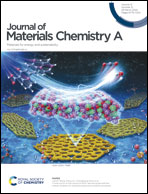Engineering the heterogeneous catalyst of protonic ceramic electrochemical cells for CO2/H2O co-electrolysis†
Abstract
Protonic ceramic electrochemical cells (PCECs) are highly promising electrochemical devices for CO2/H2O co-electrolysis reactions. However, conventional Ni/BaZr0.4Ce0.4Y0.1Yb0.1O3 (BZCYYb) heterogeneous catalysts have exhibited limited catalytic activity for CO2 methanation, hindering their further utilization and application. To address this challenge, we have developed a Ca-modified Ni/BZCYYb heterogeneous catalyst. We firstly evaluated the CO2 conversion of the Ca–Ni/BZCYYb catalyst in a packed bed reactor, and found that it exhibited higher CO2 conversion at lower operating temperature compared to the Ni/BZCYYb catalyst. Furthermore, we have demonstrated significantly improved CO2–H2O co-electrolysis performance in PCECs by modifying the fuel electrode with a Ca–Ni/BZCYYb heterogeneous catalyst. This modification results in a substantially improved CO2 conversion of ∼40% and CH4 production of 1.22 ml min−1 at 500 °C compared to the reference PCECs, validating the practical applicability of our approach in electrochemical devices. Surface characterization and density functional theory calculations reveal that CaO donates electrons to the BZCYYb catalyst support, facilitating the formation of oxygen vacancies, which provide preferential sites for CO2 adsorption, thus enhancing CO2 activation. This study demonstrates the potential of engineering the surface basicity for PCECs operating at low temperatures.

- This article is part of the themed collection: 2024 Journal of Materials Chemistry A HOT Papers


 Please wait while we load your content...
Please wait while we load your content...